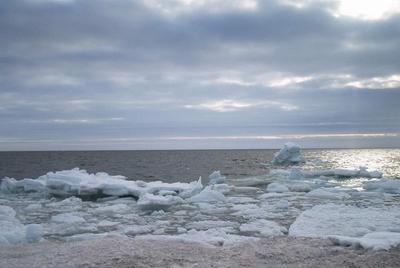25 April, 2003
P>Off to Ice Camp
Today in Cape Krusenstern, Kotlik and Imik
lagoons, 30 miles north of Kotzebue
We began our day by
packing 2 large sleds full of scientific instruments, food and personal
gear. We mounted our snow machines, attached the sleds and took off,
traveling 30 miles across the frozen Kotzebue Sound and up the coast to
Cape Krusenstern National Monument (it is a large lagoon, not a
statue). Along the way we saw many hunting and fishing camps. The
local people come to different camps to hunt at different times of the
year as a way to subsidize the food which a job can provide
(subsistence hunting).
What science is happening?
We had a lot of work to do so we split up into two teams. Alex,
Lisa and Melinda stayed at Krusenstern and drilled holes for tomorrow’s
sampling. Terry and I headed 40 more miles north to the lagoons of
Kotlik and Imik to test the holes Terry and Melinda drilled on
Wednesday. Why do you think that we don’t sample the same day that
we drill the holes?
Terry and I did the same tests that we did last Monday.
1.)First
we checked water quality with the CTD diver to test for water
Conductivity (how much salt is in the water), Temperature and
Depth.
2.) We used a Seki Disc (a black and white disc on a rope) We
drop it down the hole and see how far down it can still be seen, in
other words how clear is the water?
3.)We release a Neskin Bottle,
where we grab water from the bottom of the lagoon.
4.) Finally, we
do two or three mud grabs. We use a ponar grab, a devise like a big
jaws that chops up mud as soon as it hits the bottom.
We tested the three sites in Kotlik and drove 10 more miles up to
Imik only to find that the holes are underwater.
The day stays light longer every day. I was very surprised when
Terry and I arrived back at camp discovered it was 10:00 pm. No wonder
I’m so tired!
Classroom Connections:
Question:
Why do you think it is a problem that the test
hole at Imik is under water?
If you said that we could not cross
the ice without falling in…sorry but you are incorrect. The ice that
Terry and Melinda measured when they drilled the holes was 6 feet
thick, while the water underneath was two feet deep or less! So
falling in wasn’t a concern. The problem is that the water on top was
from rain and melting ice.
Question
So what is the
difference between rain and ice when they melt and the lagoon or sea
water?
Hint: What do you put on your sidewalk when it is icy?
Do you think creatures will behave differently or even have trouble
living if some of their living conditions change?
Reflections
The rain and warm
weather have made travel difficult. On our trip to the remote lagoons,
Terry (the snow machine expert) and I (the snow machine trainee) chose
to travel on the sea ice because the snow had mostly melted on the
tundra. We ran into ice called Chock ice. That is when the ice first
begins to break up. Instead of just breaking apart, the tides push it
together and it starts making some pressure ridges and cracks called
leads. We had about 2 miles of a roller coaster ride. I will admit I
was very nervous, even though I was with a skilled traveler. However,
when we were done, I was disappointed to learn that we were taking
another route home!
Links
Learn
more about our project here
View curriculum for this project, “Ask a Scientist” and
learn about other Arctic Real Time research at Arctic Alive
City of
Kotzebue Webpage
Listen to the local radio station KOTZ live

1.) Lisa talking on the satelite phone during our Arctic Alive conference call.

2.) This is me talking with several classes around te country during our Arctic Alive conference call.

3.) This is our cabin at the park service.

4.) Going to see the fish took on a whole new meaning.

5.) On the way to Inik lagoon we could see where the sea ice was breaking up. It made for some interesting snow mobiling until we were able to get to the beach. The early spring ice break-up caused a lot of travel problems.
Contact the TEA in the field at
.
If you cannot connect through your browser, copy the
TEA's e-mail address in the "To:" line of
your favorite e-mail package.
|









